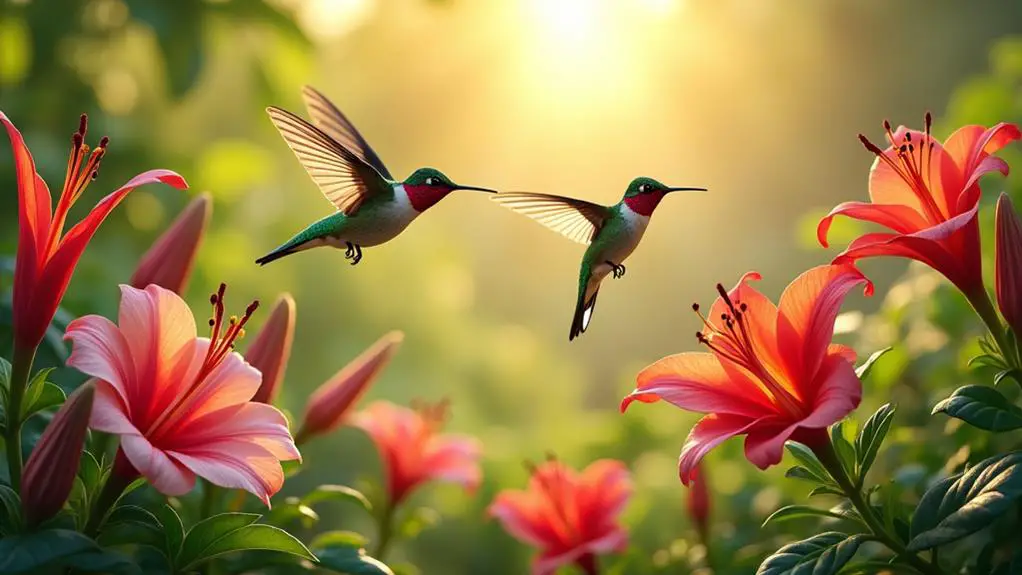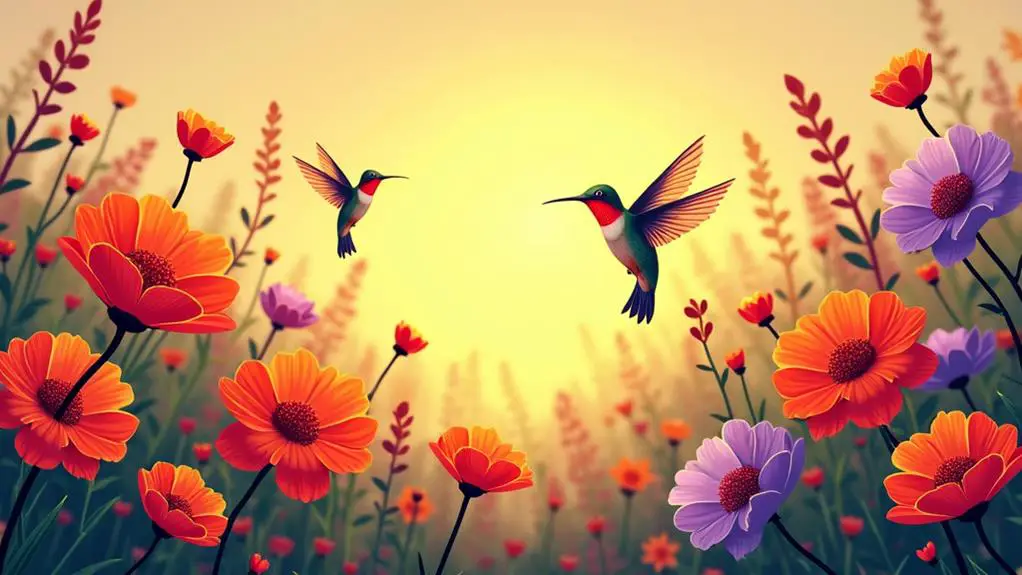You might not know that hummingbirds have a specialized tongue that beats in and out of their beak up to 13 times per second, allowing them to gather nectar at an incredible pace. But what's equally fascinating is that certain flowers have evolved to cater to this unique feeding behavior. For instance, trumpet-shaped blooms like honeysuckle and fuchsia direct the bird's beak to the nectar, ensuring a precise energy transfer. But which flowers are the most effective at attracting these tiny, iridescent birds to your garden?
Key Takeaways
- Trumpet-shaped flowers like honeysuckle, fuchsia, and lantana attract hummingbirds by directing their beaks to the nectar.
- Red blooms with long, tube-shaped structures, such as Red Velvet salvia and Ruby Rarities, are hummingbird magnets.
- Nectar-rich flowers like salvias, coral bells, and coral honeysuckle provide a constant food source for hummingbirds during the summer.
- Impatiens, Bleeding Heart, and Hellebores are hummingbird favorites that thrive in shaded areas.
- Incorporating long-blooming flowers like Salvias, Trumpet Vines, and Coral Bells ensures a steady food supply for hummingbirds throughout the year.
Trumpet-Shaped Flowers for Hummingbirds

With their long, extendable tongues, hummingbirds are naturally drawn to trumpet-shaped flowers that allow them to access nectar deep within the bloom.
You'll often find these flowers in humid, tropical hummingbird habitats, where they thrive in the warm, sunny conditions.
Trumpet-shaped flowers have evolved to attract hummingbirds, with adaptations that cater to their unique feeding style.
The long, tube-like shape of the flower directs the hummingbird's beak to the nectar, ensuring a precise and efficient transfer of energy.
As you create a hummingbird-friendly garden, incorporating trumpet-shaped flowers will increase the chances of attracting these birds.
Look for flowers with long, narrow tubes, such as honeysuckle, fuchsia, and lantana, which are all ideal for hummingbirds.
Red Blooms Hummingbirds Adore Most
Most hummingbirds have a strong affinity for red blooms, which are often more abundant in their natural habitats than other colors.
You'll notice that hummingbirds are drawn to red flowers with long, tube-shaped structures, as these resemble the shape of their beaks. Red Velvet salvia, for instance, is a hummingbird magnet, with its bright red spikes that bloom from mid-summer to fall.
Another favorite is Ruby Rarities, a type of fuchsia that boasts vibrant red flowers with long, tubular shapes.
When planting red blooms, keep in mind that hummingbirds are also attracted to flowers with high nectar concentrations.
You can plant red flowers with nectar-rich blooms, like coral honeysuckle or red columbine, to provide an added incentive for hummingbirds to visit.
Nectar-Rich Flowers for Summer

Hummingbirds frequent gardens that offer a constant supply of nectar-rich flowers, particularly during the summer months when they need to fuel their high metabolism.
You can attract these birds to your garden by planting summer blooms that are rich in nectar, as they provide the necessary energy for hummingbirds to survive the hot weather.
Some heat-tolerant flowers that are perfect for your summer garden include salvias, trumpet-shaped flowers like honeysuckle and fuchsia, and coral bells.
These flowers aren't only nectar-rich but also bloom for an extended period, providing a constant source of food for hummingbirds.
Plant them in areas that receive full sun to partial shade, depending on the specific flower requirements.
When selecting summer blooms, opt for flowers with long, tube-shaped structures, as these allow hummingbirds to access the nectar easily.
Also, consider plants with red, orange, or purple flowers, as these colors are highly attractive to hummingbirds.
Hummingbird Favorites in Shade
Frequently, hummingbirds venture into shaded areas to escape the intense summer sun, and clever gardeners can capitalize on this behavior by planting flowers that thrive in shade.
You can create a shaded oasis that attracts these avian wonders by incorporating shade dwellers and woodland gems into your garden.
- Impatiens: These colorful flowers come in a variety of shapes and sizes and are perfect for shaded areas. Their nectar-rich blooms will attract hummingbirds and add a pop of color to your garden.
- Bleeding Heart: With heart-shaped flowers dangling from arching stems, Bleeding Heart is a romantic addition to any shaded garden. Hummingbirds love its nectar-rich blooms, and you'll love its delicate charm.
- Hellebores: Commonly known as Christmas Roses, Hellebores are low-maintenance, shade-loving flowers that bloom in late winter to early spring. Their nodding, bell-shaped flowers are a hummingbird favorite.
- Coral Bells: With maple-like leaves and airy, bell-shaped flowers in shades of pink and coral, Coral Bells add a delicate touch to shaded areas. Hummingbirds adore their nectar-rich blooms, and you'll appreciate their low-maintenance requirements.
Long-Blooming Flowers for Year-Round

Your hummingbird garden can thrive year-round with flowers that bloom for an extended period, providing a constant nectar supply to attract these avian visitors.
Long-blooming flowers are essential to maintain a steady food source, especially during periods when other flowers are scarce.
Consider incorporating Summer bloomers like Salvias, Trumpet Vines, and Honeysuckles into your garden.
These flowers bloom for several weeks, providing a consistent nectar supply during the peak summer months.
For an even longer blooming period, opt for Everlasting varieties like Coral Bells, Bee Balm, and Cardinal Flower.
These perennials produce flowers for several months, often from mid-summer to early fall.
By incorporating these long-blooming flowers into your garden, you'll create a hummingbird haven that attracts these birds throughout the year.
Remember to choose flowers that are native to your region and suitable for your climate to ensure a thriving garden.
Frequently Asked Questions
Do Hummingbirds Prefer Flowers With Fragrances or Scents?
You'll find that hummingbirds aren't drawn to sweet aromas or floral bouquets like bees are; instead, they're attracted to visual cues like color and shape, suggesting they prioritize nectar's taste over fragrance.
Can I Use Hummingbird Feeders Instead of Flowers?
You think you can outsmart Mother Nature with a feeder, but hummingbirds crave more than just sugar water. Yes, you can use feeders, but don't forget feeder maintenance and strategic feeder placement to keep them coming back.
How Often Should I Water Flowers to Attract Hummingbirds?
You should water flowers when the top 1-2 inches of soil feel dry to the touch, following a flexible water schedule that adjusts to weather conditions, ensuring optimal soil moisture levels for healthy plant growth.
Will Hummingbirds Visit Flowers in Containers or Pots?
You'll be flooded with hummingbirds if you optimize your container setup! Don't worry about pot constraints, as hummingbirds will visit flowers in containers or pots, but strategic container placement near feeders and sunny spots is key to attracting these birds.
Do Hummingbirds Have a Favorite Time of Day to Visit Flowers?
You'll notice hummingbirds make morning visits to flowers for nectar-rich fuel, then return for afternoon delights when they're more active and seeking energy boosts to power their high metabolism and rapid heartbeat.
Conclusion
As you plant your hummingbird-friendly garden, remember "variety is the spice of life." By incorporating trumpet-shaped flowers, red blooms, nectar-rich flowers, and long-blooming varieties, you'll create a haven that attracts these iridescent birds. With a diverse selection of flowers, you'll ensure a constant energy supply for hummingbirds, keeping them coming back for more. By doing so, you'll be well on your way to creating a hummingbird haven that's the envy of the neighborhood.





